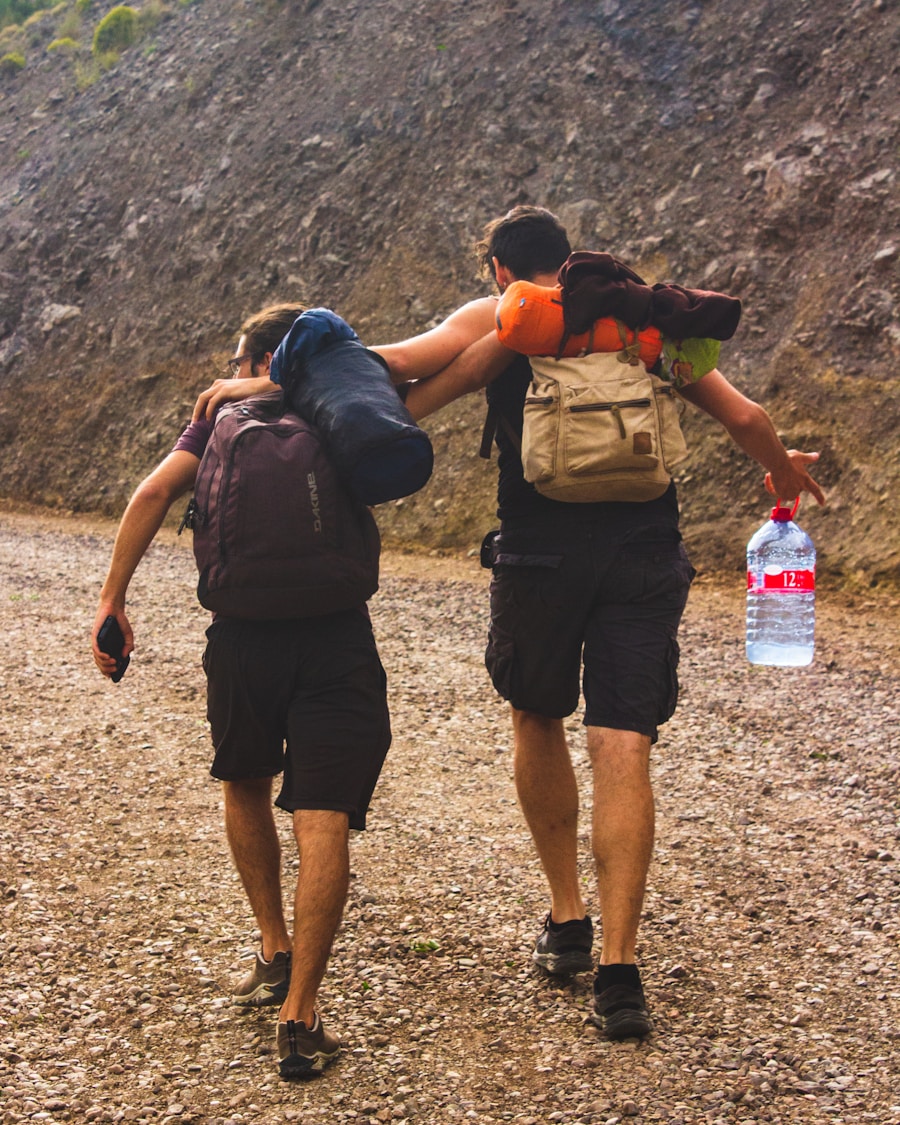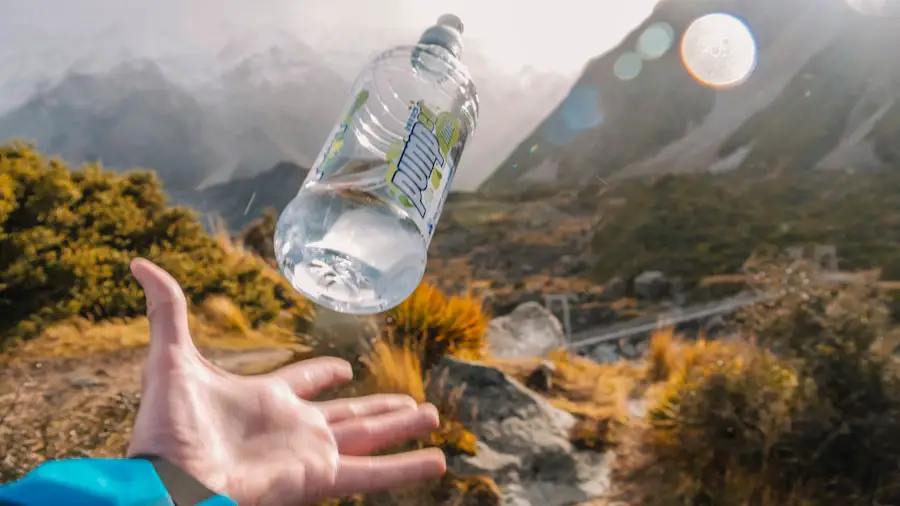Hydration is a critical component of outdoor activities, particularly hiking, where the body is subjected to physical exertion and environmental stressors. When hiking, the body loses water through sweat, respiration, and even urination. This loss can lead to dehydration, which can impair physical performance, cognitive function, and overall well-being.
Proper hydration helps maintain optimal body temperature, joint lubrication, and nutrient transport, all of which are essential for a successful hiking experience. Moreover, staying hydrated can enhance endurance and reduce fatigue, allowing hikers to enjoy their journey without the debilitating effects of dehydration. The importance of hydration extends beyond mere physical performance; it also plays a significant role in safety.
Dehydration can lead to serious health issues such as heat exhaustion or heat stroke, particularly in warmer climates or during strenuous hikes. In extreme cases, severe dehydration can result in confusion, dizziness, and even unconsciousness. Therefore, understanding the importance of hydration is not just about improving performance; it is also about ensuring safety on the trail.
Hikers must prioritize their hydration needs to enjoy their adventure fully and return home safely.
Key Takeaways
- Proper hydration is crucial for hiking as it helps maintain energy levels, regulate body temperature, and prevent muscle cramps and fatigue.
- Factors affecting hydration needs during hiking include weather conditions, intensity and duration of the hike, individual sweat rates, and altitude.
- Recommended water intake for hiking is around 0.5 to 1 liter per hour, but individual needs may vary.
- Signs of dehydration to watch out for during hiking include dark urine, dizziness, fatigue, and dry mouth.
- Tips for staying hydrated on the trail include drinking water regularly, using electrolyte supplements, and monitoring urine color.
Factors Affecting Hydration Needs
Several factors influence an individual’s hydration needs while hiking, making it essential for hikers to assess their unique circumstances before hitting the trail. One of the most significant factors is the intensity and duration of the hike. Longer and more strenuous hikes will naturally require more water intake due to increased sweat loss.
For instance, a hiker traversing a steep mountain trail will likely need more water than someone walking along a flat, well-maintained path. Additionally, the temperature and humidity levels play a crucial role; hot and humid conditions can lead to accelerated fluid loss through perspiration. Another critical factor is individual physiology.
Each person’s body composition, metabolism, and acclimatization to heat can affect how much water they need. For example, larger individuals or those with higher muscle mass may require more fluids than smaller individuals due to increased metabolic demands. Furthermore, hikers who are not accustomed to high temperatures may find themselves sweating more profusely as their bodies struggle to adapt.
Age and health conditions also play a role; older adults may have diminished thirst sensations and may not recognize their need for hydration as readily as younger individuals. Understanding these factors can help hikers tailor their hydration strategies effectively.
Recommended Water Intake for Hiking

Determining the appropriate amount of water to consume while hiking can be challenging due to the various factors at play. However, a general guideline suggests that hikers should aim for approximately half a liter (about 17 ounces) of water per hour of moderate activity in moderate temperatures. This recommendation can vary significantly based on the intensity of the hike and environmental conditions.
For instance, during a vigorous hike in hot weather, water intake may need to increase to as much as one liter (about 34 ounces) per hour to compensate for higher sweat loss. In addition to these general guidelines, hikers should also consider their personal hydration needs based on their unique circumstances. Monitoring urine color can be an effective way to gauge hydration status; pale yellow urine typically indicates adequate hydration, while dark yellow or amber urine suggests dehydration.
It is also essential to listen to one’s body; feelings of thirst should not be ignored, as they are often the first signs that the body requires more fluids. By being mindful of these recommendations and personal cues, hikers can better manage their hydration needs throughout their journey.
Signs of Dehydration
| Signs of Dehydration | Description |
|---|---|
| Thirst | Feeling thirsty is a common sign of dehydration. |
| Dark Urine | Urine that is dark yellow or amber in color can indicate dehydration. |
| Dry Mouth | A dry or sticky feeling in the mouth can be a sign of dehydration. |
| Fatigue | Feeling tired or lethargic can be a symptom of dehydration. |
| Dizziness | Feeling lightheaded or dizzy can be a sign of dehydration. |
Recognizing the signs of dehydration is crucial for hikers to ensure they remain safe and healthy on the trail. Early symptoms often include increased thirst, dry mouth, and fatigue. As dehydration progresses, more severe symptoms may manifest, such as dizziness, headaches, and decreased urine output.
In extreme cases, individuals may experience confusion or fainting spells, which can pose significant risks in remote hiking environments where immediate medical assistance may not be readily available. It is important for hikers to be proactive in monitoring their hydration status rather than waiting for symptoms to appear. Regularly checking in with oneself about thirst levels and energy can help catch dehydration early on.
Additionally, hikers should be aware that certain factors—such as altitude—can exacerbate dehydration symptoms. At higher elevations, the air tends to be drier, leading to increased fluid loss through respiration. Therefore, being vigilant about hydration is essential for maintaining both physical performance and safety during hikes.
Tips for Staying Hydrated on the Trail
Staying hydrated while hiking requires planning and awareness. One effective strategy is to establish a hydration schedule before embarking on a hike. Setting reminders to drink water at regular intervals can help ensure that fluid intake remains consistent throughout the journey.
Carrying a water bottle or hydration pack that is easily accessible encourages frequent sipping rather than waiting until thirst sets in. Another useful tip is to consume hydrating foods during breaks. Fruits such as watermelon or oranges contain high water content and can contribute to overall hydration levels while providing essential nutrients.
Additionally, electrolytes play a vital role in maintaining hydration balance; incorporating electrolyte-rich drinks or snacks can help replenish lost minerals during strenuous hikes. By combining these strategies with regular water intake, hikers can effectively manage their hydration needs on the trail.
Hydration Gear for Hiking

The right gear can significantly enhance a hiker’s ability to stay hydrated during their adventures. Hydration packs have gained popularity among outdoor enthusiasts due to their convenience and hands-free design. These packs typically feature a reservoir that holds water and a tube that allows hikers to sip without stopping.
This design encourages regular fluid intake and makes it easier to stay hydrated during challenging sections of a hike. In addition to hydration packs, traditional water bottles remain a reliable option for many hikers. When selecting a water bottle, it is essential to choose one that is lightweight and durable while also being easy to carry in a backpack or attached externally.
Some hikers prefer insulated bottles that keep water cool for extended periods, especially in hot weather conditions. Regardless of the choice between packs or bottles, ensuring that the gear is functional and accessible will greatly enhance hydration efforts on the trail.
Hydration Strategies for Different Terrains
Different terrains present unique challenges when it comes to maintaining proper hydration levels while hiking. In arid environments such as deserts or dry mountainsides, hikers must be particularly vigilant about their fluid intake due to increased evaporation rates and limited access to water sources. In these situations, planning ahead by carrying extra water and knowing where potential refill points are located becomes crucial.
Conversely, hiking in humid or wet environments may lead some individuals to underestimate their hydration needs due to cooler temperatures or perceived moisture in the air. However, even in these conditions, sweat loss can still occur significantly during exertion. Hikers should remain aware of their bodies’ signals and continue drinking regularly regardless of external conditions.
Tailoring hydration strategies based on terrain not only enhances performance but also ensures safety throughout the hike.
Post-Hiking Hydration and Recovery
Post-hiking hydration is just as important as staying hydrated during the hike itself. After completing a trek, the body requires replenishment of lost fluids and electrolytes to aid recovery and restore balance. Drinking water immediately after finishing a hike helps kickstart this recovery process; however, it is essential not to overhydrate too quickly as this can lead to discomfort or even hyponatremia—a condition caused by an imbalance of sodium levels in the body.
In addition to plain water, incorporating electrolyte-rich beverages or snacks post-hike can further support recovery efforts by replenishing lost minerals through sweat. Foods like bananas or sports drinks can provide necessary potassium and sodium levels that may have been depleted during physical exertion. By prioritizing post-hiking hydration strategies, individuals can enhance recovery times and prepare themselves for future adventures on the trail.
When preparing for a hiking trip, it’s important to consider how much water to bring along to stay hydrated. According to a recent article on taketravelinfo.com, having a reliable water bottle or hydration pack is essential for any outdoor adventure. This article provides tips on choosing the right water container for hiking and emphasizes the importance of staying hydrated while on the trail. So, before heading out on your next hiking excursion, be sure to check out this helpful guide on the best travel camera backpacks to ensure you have the right gear to keep you hydrated throughout your journey.
Love travel? Join Our Facebook Community For More Tips.
FAQs
How much water should I bring for hiking?
It is recommended to bring at least 0.5 to 1 liter of water per hour of hiking, depending on the intensity of the hike and the weather conditions.
What factors should I consider when determining how much water to bring for hiking?
Factors to consider include the length and intensity of the hike, the weather conditions, the availability of water sources along the trail, and individual hydration needs.
How can I stay hydrated while hiking?
To stay hydrated while hiking, it is important to drink water regularly, even before feeling thirsty. It is also helpful to bring electrolyte-replacement drinks or snacks to replenish lost electrolytes.
What are the risks of not bringing enough water for hiking?
Not bringing enough water for hiking can lead to dehydration, which can cause fatigue, dizziness, headaches, and in severe cases, heat stroke. It is important to stay properly hydrated to avoid these risks.
Are there any tips for managing water consumption while hiking?
Some tips for managing water consumption while hiking include drinking small amounts of water regularly, using a hydration pack or water bottles with easy access, and planning to refill water at designated points along the trail.
